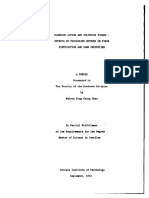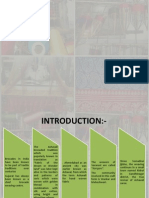Manufacturing Process
Manufacturing Process
Uploaded by
Kennaa BekeleCopyright:
Available Formats
Manufacturing Process
Manufacturing Process
Uploaded by
Kennaa BekeleCopyright
Available Formats
Share this document
Did you find this document useful?
Is this content inappropriate?
Copyright:
Available Formats
Manufacturing Process
Manufacturing Process
Uploaded by
Kennaa BekeleCopyright:
Available Formats
Features of Jute Fibre
Jute fibre is 100% bio-degradable and recyclable and thus environmentally friendly. It is a natural fibre with golden and silky shine and hence called The Golden Fibre. It is the cheapest vegetable fibre procured from the bast or skin of the plant's stem. It is the second most important vegetable fibre after cotton, in terms of usage, global consumption, production, and availability. It has high tensile strength, low extensibility, and ensures better breathability of fabrics. Therefore, jute is very suitable in agricultural commodity bulk packaging. It helps to make best quality industrial yarn, fabric, net, and sacks. It is one of the most versatile natural fibres that have been used in raw materials for packaging, textiles, non-textile, construction, and agricultural sectors. Bulking of yarn results in a reduced breaking tenacity and an increased breaking extensibility when blended as a ternary blend. Advantages of jute include good insulating and antistatic properties, as well as having low thermal conductivity and a moderate moisture regain. Other advantages of jute include acoustic insulating properties and manufacture with no skin irritations. Jute has the ability to be blended with other fibres, both synthetic and natural, and accepts cellulosic dye classes such as natural, basic, vat, sulfur, reactive, and pigment dyes. Jute can also be blended with wool. By treating jute with caustic soda, crimp, softness, pliability, and appearance is improved, aiding in its ability to be spun with wool. Liquid ammonia has a similar effect on jute, as well as the added characteristic of improving flame resistance when treated with flame proofing agents.
Jute Manufacturing in Jute Mills Raw jute in the form of bales is processed in jute mills to produce hessian, sacking, jute yarn, bags, and other useful products. Raw jute bales from jute fields or suppliers, carried by trucks are unloaded are stacked in the jute mills godown. The production of jute goods from raw jute processing involves the following steps:
Selection : In the selection process, raw jute bales are opened to find out any defect and to remove the defective portion by experienced workers. Raw jute bales are of two types i.e. 150 kg weight and 180 kg weight with or without top portion cutting. The bales are assorted according to end use like Hessian weft, Sacking wrap, Sacking weft etc. After selection, jute bales are carried to softening section.
Softening : In softening process jute are made soft and pileable. Two methods are used for softening; use of softening machine and use of jute good spreader. Generally an emulsion plant with jute softener machine is used to lubricate and soften the bark and gummy raw jute. The emulsion plant consists of gear pump, motor, vat, jet sprayer, nozzles, emulsion tank and the jacket. In this softening process jute becomes soft and pileable and suitable for carding.
Piling and pile Breaking : The main function of pile breaker is to break the pile and serve it to the carding machines. The softener machine output material carried by pilemen through bile to the pile place for pilling. During piling superficial moisture penetrates inside fibre and "Thermo fillip" action take place which soften the hard portion of the root. After piling for nearly 24 hours the pile breakers carry the material to the carding machine. Generally root cutting is done after piling near the hand feed breaker carding machine. The root weight varies from 5 to 7% of the total weight of jute.
Carding : Carding is a combining operation where jute reeds are splitted and extraneous matters are removed. Jute fibres are formed into ribbon called "sliver". There are three different carding sections: (i) breaker carding (ii) inner carding (iii) and finisher carding Breaker Carding : In different jute mills the carding operations has been carried out in two ways: a. Hand feed breaker carding b. Roll feed breaker carding The material after piling more than 24 hours is used in hand feed breaker where the material after piling for 12 hours used in the roll feed carding. In the Breaker carding machine soften jute after piling is feed by hand in suitable weight. The machine by action with different rollers turns out raw jute in the form of jute sliver for finisher carding. In this process root cutting is necessary before feeding the material to the hand feed breaker carding machine. Finisher Carding: Finisher carding machine make the sliver more uniform and regular in length and weight obtained from the Breaker carding machine. Finisher carding machine is identical to the Breaker carding machine, having more pair of rollers, staves, pinning arrangement and speed. Nearly 4 to 12 slivers obtained from Breaker carding machine is fed on this machine. The material thus obtained is send to drawing section.
Drawing : Drawing is a process for reducing sliver width and thickness by simultaneously mixing 4 to 6 sliver together. There are three types of Drawing Frame machine. In most mills 3 Drawing passages are used in Hessian and 2 Drawing passages are used in Sacking.
First Drawing : The slivers obtained from finisher carding machine is fed with four slivers on to the first drawing frame machine. The first drawing frame machines makes blending, equalising the sliver and doubling two or more slivers, level and provide quality and colour. This machines includes delivery roller, pressing roller, retaining roller, faller screw sliders, check spring, back spring, crimpling box etc.
Second Drawing : In second drawing, the Second Drawing Frame machine obtain the sliver from the First drawing machine and use six slivers and deliveries per head. The Second Drawing machine makes more uniform sliver and reduce the jute into a suitable size for third drawing.
Third Drawing : In the third drawing, the Third Drawing frame machine uses the sliver from second drawing. The Third Drawing machine is of high speed makes the sliver more crimpled and suitable for spinning.
Spinning is the process for producing yarn from sliver obtained from Third drawing. In the spinning process slivers are elongated and fibres are twisted into yarn to impart strength. Spun yarns in the spinning process are wound onto Bobbins. The entire time is called an average cycle time. The time for replacing the bobbins full of yarn by empty bobbins is called softening time. The jute spinning frame machine is fitted with slip draft zone and capable of producing quality yarns at high efficiency with auto-doting arrangements also. A 4', pitch slip-draft sliver frames available of 20 spindles 100 spindles, having a production range 8 lbs to 28 lbs with a flyer speed of 3200 to 4000 RPM. Spinning of several types of yarn is processed by spinning frame machine using different kinds of bobbins, such as: Food Grade HCF, Sacking Wrap, Hessian Wrap, and Hessian Weft.
Winding is a process which provides yarn as spools and cops for the requirement of beaming and weaving operations. There are two types of winding: 1. Spool Winding 2. Cop Winding
Spool Winding In Spool Winding yarn is produces for warp (the longitudinal yarn). Spool winding machine consists of a number of spindles. There is wide variation in the number of spindles per machines from one make to another. Productivity of spool winding depends on the surface speed of the spindle and machine utilisation. Spool winding machine uses the bobbins contain smaller length of yarn. This machine wound the yarn into bigger packages known as 'spool'. The Spool are used in making sheets of yarn to form warp portion used during interlacements of weaving.
Cop Winding Cop Winding machine obtain yarns from the spinning machines. The spinning bobbins are placed on a suitable pin on top of the cop machine and yarn tension is maintained by means of a small leaver. The yarn on the bobbins is converted into hollow cylindrical package said to be cop. The cop is used to form Transverse thread during interlacement of weaving. Generally a cop winding machines consist 120 spindles. Beaming process is follows after spool winding. In Beaming operation yarn from spool is wounded over a beam of proper width and correct number of ends to weave jute cloth. To increase the quality of woven cloth and weaving efficiency, the wrap yarns are coated with starch paste. Adequate moisture is essential in this process. Quality characteristic of a beam is width of beam - number of ends and weight of stand and there is a continuous passage of yarn through starch solution from spools to the beam. Starch solution in water contains tamerine kernel powder (TKP), antiseptic - sodium silica fluoride (NaSiF4) and its concentration varies with the quality of yarn. Weaving is a process of interlacement of two series of threads called "wrap" and "weft" yarns to produce the fabric of desired quality. There are separate looms for hessian and sacking in weaving section. The Hessian looms, shuttle which contents cops (weft yarn) is manually changed. The sacking looms are equipped with eco-loader to load a cop automatically into the shuttle.
Damping is a manual process in which the rolled woven cloth is unrolled and water is sprinkled on it continuously to provide desired moisture. Each roll is generally 104 yards or 95.976 meters. Calendaring: Calendaring is a process similar to ironing of fabric. After damping the damped fabric passes through pairs of heavy rollers rendering threads in fabric flattened and improve the quality and appearance. Lapping: Lapping is the process in which Hessian fabrics are folded into the required size used in "Bale press" operation on the lapping machine. Cutting, Hemming & Heracles sewing: Cutting is the process where the sacking/hessian cloth is cut to the required length for making bags for different size and capacity. In Hemming process, the raw edges of jute cloth cut pieces are shown by folding it with sewing machine. In Heracles sewing the sides of sacking cloth cut pieces are shown to make a complete bag. Bailing: After the bags are stitched or hessian lumps as the case may be, they are piled and packed in standard packing as per requirement and is bailed by iron strips applying hydraulic force into hydraulic bale pressing machine.
You might also like
- Color and TextureDocument8 pagesColor and TextureInterweave100% (3)
- Prince Textile MillsDocument30 pagesPrince Textile MillsAntariksh KumarNo ratings yet
- Jute Manufacturing ProcessDocument8 pagesJute Manufacturing Processhabibitltd50% (2)
- Fabric GeometryDocument8 pagesFabric GeometryMasud Rana100% (1)
- 10th Century AD Textiles From Female Burial II-301 at Gnezdovo, RussiaDocument17 pages10th Century AD Textiles From Female Burial II-301 at Gnezdovo, RussiaRavnhild RagnarsdottirNo ratings yet
- Fire HoseDocument7 pagesFire Hosermaffireschool100% (4)
- Jute Yarn SpinningDocument15 pagesJute Yarn SpinningDebasish GhoshNo ratings yet
- Weaving Process Interlaces The WarpDocument8 pagesWeaving Process Interlaces The WarpChetna SinghNo ratings yet
- English Booklet - Banana Pseudo Stem Final - 27!04!2011Document32 pagesEnglish Booklet - Banana Pseudo Stem Final - 27!04!2011Piyush Moradiya100% (1)
- K C Mouldings CatalogueDocument90 pagesK C Mouldings CatalogueTomas Cruz0% (1)
- BS Iso TR 08363-1997 (1999)Document16 pagesBS Iso TR 08363-1997 (1999)Олег СоловьевNo ratings yet
- FS PPT 1Document23 pagesFS PPT 1SHREYA TANEJANo ratings yet
- Dual Laminated Fiberglass Reinforced Polymer (FRP) - MACAR Pipe & Fittings - PresentationDocument21 pagesDual Laminated Fiberglass Reinforced Polymer (FRP) - MACAR Pipe & Fittings - PresentationJulio Humberto Díaz Rondán100% (1)
- Module 2 PDFDocument98 pagesModule 2 PDFPrathmesh Bharuka100% (1)
- Non Wovens - FinalDocument43 pagesNon Wovens - FinalBijal DedhianGosarNo ratings yet
- Draft PTYDocument17 pagesDraft PTYAruna KumarasiriNo ratings yet
- Unconventional Fibre PlantsDocument18 pagesUnconventional Fibre PlantsRajendra Singh MeenaNo ratings yet
- Non Woven Manufacturing ProcessesDocument2 pagesNon Woven Manufacturing ProcessesBuntyNo ratings yet
- Meltblown TechnologyDocument7 pagesMeltblown TechnologyRonik J100% (1)
- BASE Textiles LimitedDocument76 pagesBASE Textiles LimitedPushpa BaruaNo ratings yet
- Computerized Sock Knitting Machine To Stephanie Hung Simartec BCI - Oct 11.2013Document4 pagesComputerized Sock Knitting Machine To Stephanie Hung Simartec BCI - Oct 11.2013Luis GarcÍaNo ratings yet
- Effect of First Heater Temperature Variations On The Polyester Yarn Properties of False Twist Texturing TechniquesDocument5 pagesEffect of First Heater Temperature Variations On The Polyester Yarn Properties of False Twist Texturing TechniquesIberê Cruz Freitas100% (1)
- Blending of Cotton Fibers PDFDocument87 pagesBlending of Cotton Fibers PDFTuan Nguyen MinhNo ratings yet
- Natural Fiber ReinforcedDocument7 pagesNatural Fiber ReinforcedMohammedAL-AthariNo ratings yet
- 04 ITMA ChemDocument87 pages04 ITMA ChemDEVANG MISTRINo ratings yet
- Introduction To Special Fabrics and FinishesDocument37 pagesIntroduction To Special Fabrics and FinishesNaimur RahmanNo ratings yet
- Manual Paper Recycling MachineDocument6 pagesManual Paper Recycling MachineShubhamDabralNo ratings yet
- 2 GinningDocument29 pages2 GinningPrincesaxena SaxenaNo ratings yet
- A Internship Report in Brabch Textile Technology For Diploma Holders.Document54 pagesA Internship Report in Brabch Textile Technology For Diploma Holders.Pawan Kumar RajputNo ratings yet
- Woven & Knit and Non Woven (Fabrics)Document13 pagesWoven & Knit and Non Woven (Fabrics)nguyenquyen9286No ratings yet
- Small-Scale Filament Winding Machine For ProducingDocument14 pagesSmall-Scale Filament Winding Machine For ProducingAlfonso CostasNo ratings yet
- PP BagDocument2 pagesPP BagFITIWINo ratings yet
- Modern Developments in WeavingDocument13 pagesModern Developments in WeavingRakeahkumarDabkeyaNo ratings yet
- 5 - FlaxDocument30 pages5 - FlaxHassaan ShamshadNo ratings yet
- Non Woven Bag Word 1Document11 pagesNon Woven Bag Word 1Bhimsen100% (1)
- Unit I - Introduction To Technical TextilesDocument15 pagesUnit I - Introduction To Technical TextilesPandurang PawarNo ratings yet
- Design and Analysis of Two Spindle Amber Charkha - A ReviewDocument4 pagesDesign and Analysis of Two Spindle Amber Charkha - A ReviewEditor IJRITCCNo ratings yet
- Questions For Tex-2013Document2 pagesQuestions For Tex-2013Emdad SarkerNo ratings yet
- Rearing TechnologyDocument142 pagesRearing TechnologyAdita AgarwalNo ratings yet
- Vortex FDocument2 pagesVortex FNipu SenNo ratings yet
- Technical YarnsDocument10 pagesTechnical YarnsNivedini uNo ratings yet
- Quality of Yarn ControlDocument12 pagesQuality of Yarn Controlsabbir2029_310230403No ratings yet
- Lyocell: Lyocell Is A Regenerated Cellulose Fiber Made From Dissolving PulpDocument3 pagesLyocell: Lyocell Is A Regenerated Cellulose Fiber Made From Dissolving PulpMiraz HossainNo ratings yet
- Textile MoodboardDocument2 pagesTextile MoodboardFaten effaNo ratings yet
- Qasir Spinning ReportDocument60 pagesQasir Spinning ReportRana AtiqueNo ratings yet
- Project WorkDocument12 pagesProject WorkSarabjot AzrotNo ratings yet
- POY TroubleshooterDocument2 pagesPOY TroubleshooterKağan Ayşe Ayan100% (1)
- POLYESTER FIBRE Manufacturing ProcessDocument4 pagesPOLYESTER FIBRE Manufacturing Processpraveen917No ratings yet
- Fiber Consumption in Nonwovens1Document12 pagesFiber Consumption in Nonwovens1gowrikathirNo ratings yet
- JIS B 0001: Technical Drawings For Mechanical EngineeringDocument7 pagesJIS B 0001: Technical Drawings For Mechanical EngineeringAMIT VERMA0% (1)
- Ecoverde BrochureDocument12 pagesEcoverde BrochureRicardina Rosibel Rodriguez MendozaNo ratings yet
- Limitations of Shuttle LoomsDocument3 pagesLimitations of Shuttle LoomsDr. J. P. Singh0% (1)
- Recent Development in Denim ManufacturingDocument24 pagesRecent Development in Denim ManufacturingMichael LiuNo ratings yet
- Melt Blown TechnologyDocument15 pagesMelt Blown TechnologyKalyan Ray Gupta100% (2)
- Size IngredientDocument16 pagesSize IngredientShamima akterNo ratings yet
- DL Texturing OBA DTY EFK enDocument28 pagesDL Texturing OBA DTY EFK enSaulo Armando Giraldo Botero100% (1)
- Weaving MachinesDocument9 pagesWeaving MachinesManoja Samarasinghe100% (2)
- Submitted by Sakshi Singh Himadri VyasDocument39 pagesSubmitted by Sakshi Singh Himadri VyasSakshi SinghNo ratings yet
- Spin Plan Bengal ThesisDocument149 pagesSpin Plan Bengal Thesisstylish eagleNo ratings yet
- Plain WeaveDocument8 pagesPlain Weaveghosh7171No ratings yet
- Alternative Methods of Joining MaterialsDocument14 pagesAlternative Methods of Joining MaterialsSharif0721No ratings yet
- Jute ProcessingDocument7 pagesJute Processingtulika_ajwaniNo ratings yet
- Jute ManufacturingDocument5 pagesJute ManufacturingRobotrix100% (4)
- Wind Power ApplicationDocument13 pagesWind Power ApplicationSagar PawarNo ratings yet
- Wet Processing I Introduction PDFDocument8 pagesWet Processing I Introduction PDFLeeroy Mupambireyi50% (2)
- Functon of Parts in Air JetDocument2 pagesFuncton of Parts in Air JetAl Amin100% (7)
- Literature ReviewDocument42 pagesLiterature ReviewJasleen ChawlaNo ratings yet
- Numerical Problems - 3 PDFDocument7 pagesNumerical Problems - 3 PDFবিশ্বজিৎ বিশ্বাস67% (3)
- knitting Views/January-February 2012 /knitting Views/January-February 2012Document3 pagesknitting Views/January-February 2012 /knitting Views/January-February 2012Sanghamitra KalitaNo ratings yet
- Arvind Textiles Internship ReportDocument107 pagesArvind Textiles Internship Reportsakshi kaul0% (1)
- Images and Descriptions of Wool Blankets and Wool, Wool/Linen CoverletsDocument14 pagesImages and Descriptions of Wool Blankets and Wool, Wool/Linen CoverletsJohn U. ReesNo ratings yet
- Defence Standard 02-801Document2 pagesDefence Standard 02-801zubimehNo ratings yet
- Performance of Woven Fabrics Containing SpandexDocument8 pagesPerformance of Woven Fabrics Containing SpandexMohammed Atiqul Hoque ChowdhuryNo ratings yet
- Project Work On Handicraft and Fabrics of RajasthanDocument59 pagesProject Work On Handicraft and Fabrics of Rajasthanmanojazmera89% (9)
- Terry Towel Some Developments For Quality ImprovementDocument7 pagesTerry Towel Some Developments For Quality ImprovementMd Habibur Rahman HabibNo ratings yet
- Welspun Internship, VapiDocument92 pagesWelspun Internship, Vapiluckyharsh19No ratings yet
- 3 Weaving UnitDocument14 pages3 Weaving Unitapi-215979386No ratings yet
- SericultureDocument11 pagesSericulturespirit571100% (1)
- A Model of An Ancient Greek Loom A Model of An Ancient Greek LoomDocument2 pagesA Model of An Ancient Greek Loom A Model of An Ancient Greek LoomdovescryNo ratings yet
- Brief Profile: M/s Kajal Polymers & Plastics Pvt. LTDDocument12 pagesBrief Profile: M/s Kajal Polymers & Plastics Pvt. LTDDhavalbhaiNo ratings yet
- Ben Dimensa EnglishDocument16 pagesBen Dimensa EnglishReddy RamiNo ratings yet
- Cluster Development ProjectDocument28 pagesCluster Development Projectsonquan1421988No ratings yet
- Performance Test Laundry DetergentsDocument35 pagesPerformance Test Laundry DetergentsWaqar Ahmed100% (1)
- LBritton Static Hazards in FIBCDocument22 pagesLBritton Static Hazards in FIBCAnonymous 1XHScfCINo ratings yet
- KJVO Controversy ++Document5 pagesKJVO Controversy ++Jesus LivesNo ratings yet
- 79 97 ET V1 S1 - Unit - 1Document8 pages79 97 ET V1 S1 - Unit - 1Aruna KumarasiriNo ratings yet
- Jacquard Handloom WeaverDocument37 pagesJacquard Handloom WeaverSammers Hbr50% (2)
- Autoconer 338 - Winding Technology.: Multi-Optionality, Know-How, InternationalityDocument8 pagesAutoconer 338 - Winding Technology.: Multi-Optionality, Know-How, InternationalityAnonymous 5XZ3VZNo ratings yet
- Angkit: Tobiran Lakban: Maranao, Lanao Del Sur Province, Northwestern Mindanao Island, Southern PhilippinesDocument1 pageAngkit: Tobiran Lakban: Maranao, Lanao Del Sur Province, Northwestern Mindanao Island, Southern PhilippinesJ Alex GintangNo ratings yet

























































































